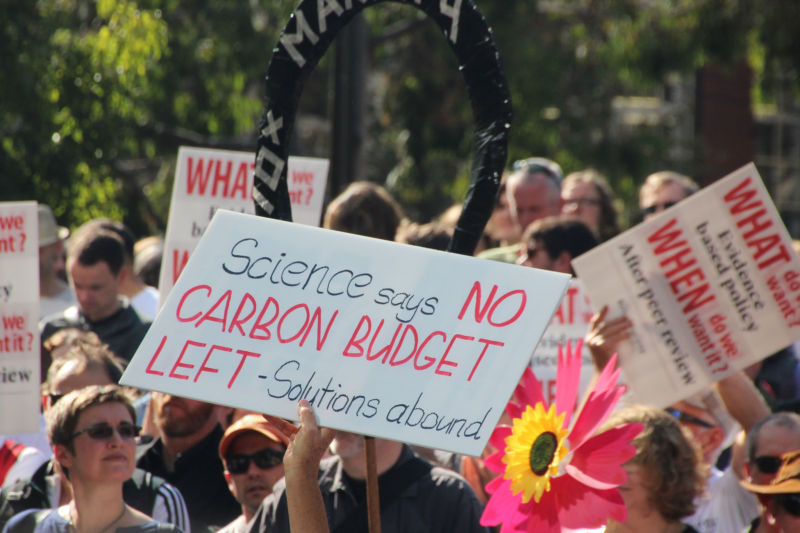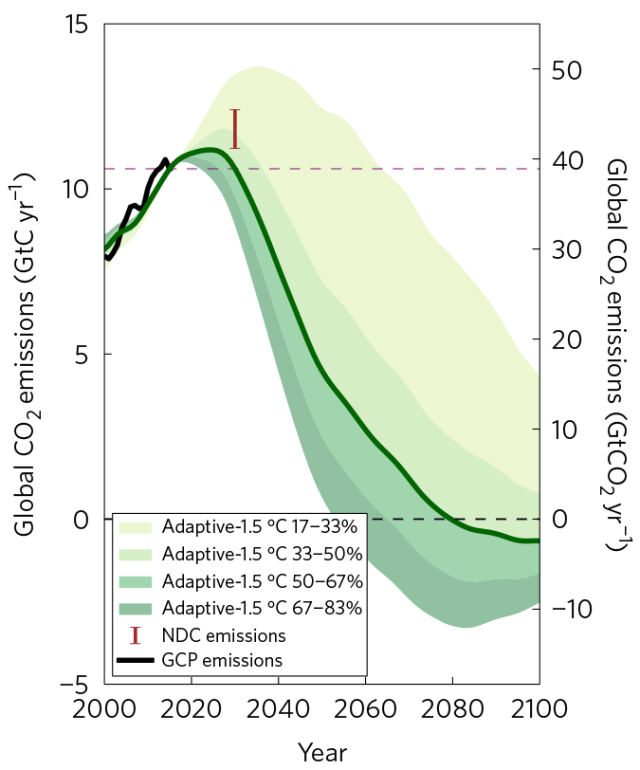
In The Guardian, the headline was “Ambitious 1.5C Paris climate target is still possible, new analysis shows.” But over at Breitbart, readers were told that “Climate Alarmists Finally Admit ‘We Were Wrong About Global Warming.’” Other headlines spanned pretty much the entire range between these two. The grist for the mill was a new study published in Nature Geoscience by a group of well-known climate scientists, but different news outlets baked very different breads with it.
That happens pretty frequently these days, but, in this case, the new study was especially complex and more easily misunderstood—even by those without a Breitbartian aggressive ideological bias against climate science.
The story in Nature Geoscience starts with a widely used figure from the latest report from the Intergovernmental Panel on Climate Change. The figure was meant to provide an easier way to represent the consequences of future greenhouse gas emissions. It turns out that the relationship between global warming and the total amount of greenhouse gas emissions since the Industrial Revolution is roughly a straight line (at least for the near future). So rather than trying to match accounting of greenhouse gas emissions with one of myriad scenarios of future gas concentrations, you have a much simpler way to describe our situation: to limit warming to less than x degrees, you can emit no more than y CO2. This is the so-called “carbon budget.”

But maybe understanding the Nature Geoscience story isn’t quite as simple as finding yourself on that graph and doing a little subtraction. The new study—led by Oxford’s Richard Millar—shows that this graph may underestimate how much “carbon budget” we currently have left before hitting 1.5 or 2 degrees Celsius. And that’s where this get complex.
The graph is based on climate model simulations using a suite of greenhouse gas concentration scenarios as input. The models simulate the movement of carbon between various forms in the air, in the ocean, and on land, and they basically dialed human greenhouse gas emissions to match the concentration in the atmosphere with the pre-determined concentration for each scenario. Because different models can show different amounts of carbon soaked up on land or in the ocean, the amount of human emissions needed to match that atmospheric concentration can vary.
If you compare the total historical emissions the models needed to get to today’s CO2 concentration with our best estimate of the actual historical emissions, there’s a mismatch. It seems like we’ve emitted more than the models did—perhaps meaning that the real land and ocean have soaked up more of our emissions than the models did (or that our real-world estimate is high).
Between 1870 and 2015, our estimate of the total amount of greenhouse gas we’ve emitted is 545±75 billion tons of carbon, which has raised the concentration of CO2 in the atmosphere to a little more than 400 parts per million. But the model simulations don’t hit 545 gigatons until the 2020s—when the concentration in the atmosphere is higher and the world is a little warmer than it is today.
So if you’re following the model relationship, 615 gigatons of carbon emissions is enough to get you to 1.5 degrees Celsius warming—the most aspirational limit in the International Paris Agreement. Since we’re currently emitting more than 10 gigatons per year, that’s only a few years away.
The researchers basically just realigned the graph to start in 2015 and at 545 gigatons of accumulated emissions instead of 1870 and at 0 gigatons. With virtual apple number 545 lined up to real-world apple number 545, it should be simpler to ask how much room is left in the apple basket.
When the researchers do that, their estimate adds an extra 130 to 170 gigatons to the carbon budget before we hit 1.5 degrees Celsius—a decade or more worth of emissions. That would obviously be good news.
Off the rails
Here is where some coverage of the story diverged from the facts of the study. Some interpreted this to mean that climate models have overestimated global warming because they were too sensitive to changes in greenhouse gases. That led to the mistaken assertion that the researchers had “reset” the projections of future warming from the last IPCC report, downgrading the future temperature rise. Two of the paper’s authors have already taken to the pages of The Guardian to set the record straight.
In reality, this study doesn’t change or challenge projected warming in any way at all. The model simulations they were relying on—run years ago now—are the same ones that were used for the IPCC report. The relationship between scenarios of greenhouse gas concentrations and global temperature is identical. The perceived difference was only a matter of how the cumulative tally of human emissions behind those concentrations was counted up.
In reality, those model projections have done an admirable job of matching the observed rise of global temperatures in recent years.
Claim of a substantial gap between model projections for global temperature & observations is not true (updated with 2017 estimate): pic.twitter.com/YHzzXtbhs9
— Gavin Schmidt (@ClimateOfGavin) September 20, 2017
There are some pretty important caveats to this study, though, as the lively Twitter discussion it produced among climate scientists can attest. The exact amount of remaining carbon budget is quite sensitive to precisely how close to 1.5 degrees Celsius warming you calculate we currently are.
Going through 2015 and using one global temperature dataset, the study estimated the human-caused warming (excluding natural variability) at 0.93 degrees Celsius. Including 2016 and working with the other major global temperature datasets can increase that number to about 1.0 or even 1.1 degree Celsius.
There’s a bit of uncertainty at the other end of the timeline, too—the baseline “pre-industrial” temperature. Some scientists argue for an earlier baseline maybe 0.1 degree Celsius cooler than the late-1800s baseline that is typically used, which would obviously now make us 0.1 degree Celsius closer to 1.5 degrees Celsius above our pre-industrial reference point. As Glen Peters of the Center for International Climate Research put it in a Twitter post, “Each 0.1°C is about 60 [gigatons of carbon] in the budget, so any change up or down 0.1°C makes a huge difference.”
Well, what are you gonna do about it?
The researchers don’t pretend their estimate of the remaining carbon budget is exactly the right answer—there’s too much uncertainty to think you can nail it so precisely. But they do think that it’s closer to the right answer than previous estimates. They write, “Hence, limiting warming to 1.5°C is not yet a geophysical impossibility but is likely to require delivery on strengthened pledges for 2030 followed by challengingly deep and rapid mitigation.”

How “challengingly deep and rapid”? Emissions would have to start dropping off a cliff in short order, hitting zero by 2080. That would require huge commitments beyond what nations pledged at the signing of the Paris Agreement. But—this study reminds us—that’s a choice we could make.
Nature Geoscience, 2017. DOI: 10.1038/NGEO3031 (About DOIs).
reader comments
174